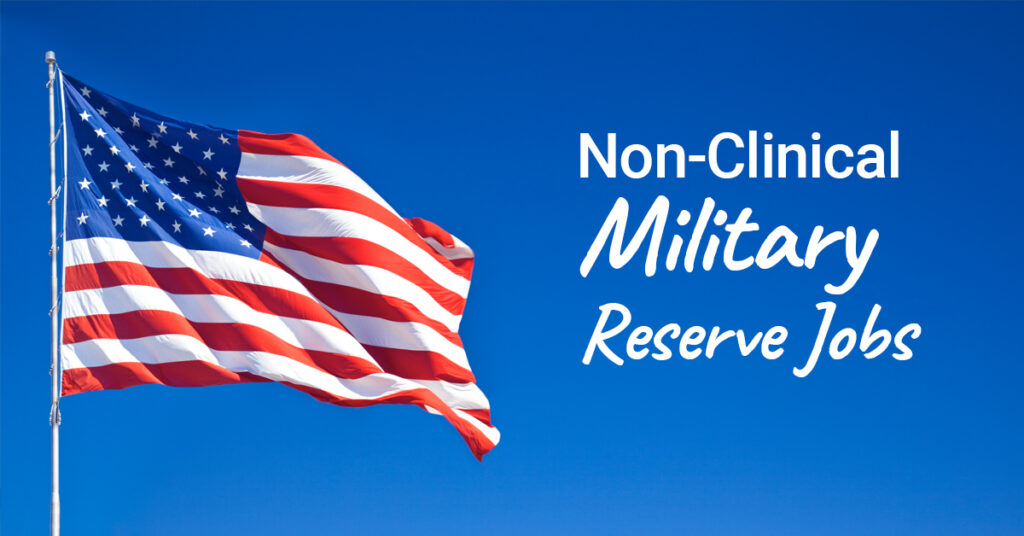The US military reserve (Army, Navy, Air Force, Marines, and Coast Guard) is a great option for those who want to serve their country while exploring roles beyond patient care. You can join the reserves and hold a number of non-clinical roles—and you’ll also be eligible for health insurance benefits, retirement contributions, and loan repayment. Plus, you’ll make some pretty competitive wages!
Interested? Read on to learn more about non-clinical military reserve jobs!
This post may contain affiliate links or codes. This won’t increase your cost, but it helps keep TNCPT alive, and free of annoying ads! Thank you for your support. 🙂
How does the military reserve work?
All branches of the U.S. military (Army, Navy, Air Force, Marines, and Coast Guard) have a reserve component as part of their respective missions. Each branch has units across the United States with people filling dual roles as service members and civilians.
The Air Force and Army also have a National Guard component. The National Guard typically responds to local and state emergencies. I have served 5 years as a health services administration officer in the Army Reserve and will be discussing this branch, since most duties, benefits, and opportunities will be similar across the branches.
Plus, more therapy positions are allocated to the Army Reserve than any other branch.
Here are some links to the various branches of military reserves:
What is the difference between enlisting and being an officer?
Let’s start with the basics. You can join the army either by enlisting or commissioning.
Enlisting (PTAs, OTAs)
In order to enlist in the army, you must have:
- A high school diploma or equivalent
- An acceptable score on the Armed Services Vocational Aptitude Battery (ASVAB) test
- An acceptable score on the physical fitness test
- A healthy physical exam
Is there an age cutoff for the US army reserves?
Age requirements differ between branches, but prospective service members may apply for waivers as needed. Enlisted soldiers are expected to attend Basic Combat Training (BCT) for approximately 12 weeks for introduction to the military and basic soldiering tasks including weapons training, uniform appearance, and fitness expectations.
BCT looks like what you typically see in the movies: obstacle courses, yelling drill sergeants, and early mornings. It is followed by Advanced Individual Training (AIT) of various lengths, where soldiers are sent to learn their specific job duties (i.e. infantryman, medic, mechanic, etc.). Enlisted soldiers can progress their careers to become Non-Commissioned Officers (typically “sergeants”) with progression in responsibility for personnel and tasks. Physical Therapist Assistants and Occupational Therapist Assistants are considered enlisted personnel.
Commissioning as an officer (PTs, OTs)
Commissioning into the military as an officer requires a passing physical fitness score and physical exam, meeting the age requirements (unless waivered), and attaining a bachelor’s degree or greater level of education.
Commissioned officers are expected to attend a Basic Officer Leader Course to prepare for assignments in the reserve. Healthcare officers of all backgrounds, including PTs, OTs, and healthcare administrators, attend the same course in San Antonio, TX, to learn basic soldiering skills and how to manage healthcare on the battlefield. Soldiers separate into different disciplines in the last weeks for specialized training.
Army officers are identified by their corresponding rank (“O” meaning officer) and grade (1-10) written as O-1 to O-10. As you progress in grades, there is increased responsibility and compensation. Doctors of Physical Therapy are commissioned as an O-3 and Masters of Occupational Therapy are commissioned as an O-2.
PTs and OTs are considered clinical specialists within their fields, but they are also responsible for administrative and leadership roles within varying units (specialty clinics, hospital sections, ambulance transportation companies, etc.)
Can speech-language pathologists (SLPs) join the military reserves?
There is not an official position for SLPs in the reserves. However, SLPs (as well as PTs and OTs) are eligible for a separate nonclinical position in the reserves outside of their clinical specialties. They would do well to check out a health administrative services officer role, which we discuss shortly.
What about assistants (OTAs and PTAs)?
As noted above, Physical Therapist Assistants and Occupational Therapist Assistants are considered enlisted personnel.
PTAs and OTAs are eligible to enlist, but they will be required to attend Basic Combat Training and Advanced Individual Training for approximately 9 months. As a reminder, this includes the typical movie sequence mentioned previously and is more physically demanding and stressful than the route for PTs and OTs.
Enlisting into the Army Reserve with an Associate’s degree may entitle the soldier to receive the grade of E-4; “E” indicating enlisted and grade similar to the officer classification above with progression from 1-9. Assistants have similar non-clinical roles within the military, but they won’t be able to oversee as many personnel or access the same resources.
It is also important to note that PTAs and OTAs can enlist into other career fields if they meet the ASVAB requirements and job availability.
What are some of the non-clinical military reserve jobs?
Some of the non-clinical roles in the military reserve can include:
- Serving as a unit movement officer to ensure all personnel and equipment are transported correctly during a deployment
- Serving as the supply officer in charge of all medical and non-medical equipment, often in excess of several million dollars
- Preparing and scheduling mandated training to be completed by a unit within the year such as scheduling ranges for marksmanship training
- Tracking administrative tasks including annual soldier evaluations, issuing awards, and ensuring soldiers are paid correctly
- Managing the unit’s fitness program designed to prepare soldiers for the Army Combat Fitness test and maintaining or improving body fat percentage
- Commanding a unit with responsibility for all personnel, mandated training, and administrative requirements
PTs and OTs should always be prepared to perform patient care and non-clinical roles to accomplish the mission of the Army and their respective units. Entry-level therapists are typically expected to perform clinical duties although this depends on the needs of the unit as a new PT/OT could instead be immediately sent for training in one of the above tasks. PTs, OTs, and SLPs can also join the reserves as health services administration officers without expectation for clinical care.
What is a health services administration officer?
This position requires a bachelor’s degree and is considered entry level as an O-1 with less responsibility and compensation, but with more opportunities for structured nonclinical training through the military.
This training can prepare officers for jobs in:
- Healthcare administration
- Network systems
- Patient administration
- Human resources
- Medical logistics
- Operations
- Finance.
As noted above, SLPs would likely benefit most from this route as therapists remain eligible for many of these positions without the traditional health services administration training.
What is expected of someone in military reserves?
Reservists attend training assembly throughout the year: 1 weekend per month and 2-4 weeks in the summer. A “battle assembly” weekend is comprised of Saturday and Sunday. Each morning and afternoon formation is considered a separate training assembly. A PTA/OTA (E-4) would make ~$75 per training assembly (~$300 per weekend). An SLP pursuing health services administration as an O-1 would make ~$109 per training assembly (~$436 per weekend.) A new OT (O-2) would make ~$126 per training assembly (~$504 per weekend) and a new PT (O-3) would make ~$146 per training assembly (~$584 per weekend). The annual summer training is paid as one training assembly rate per day with a housing and food stipend.
There are 24 additional training assembly periods available throughout the year which can be used to attend CEU’s to maintain licensure (as an OT or PT) or to complete work that was unfinished during a weekend assembly.
How does compensation work in the military reserves?
Compensation increases every 2 years and when promoted. With 10 years of service, assistants can make ~$500 and therapists can make ~$1000 per weekend. With 20 years of service, assistants can make ~$750 and therapists ~$1300 per weekend. Soldiers may also be reimbursed for mileage and hotel expenses during training, are offered competitive health insurance plans, given a retirement with up to 5% match and pension, and possible loan repayment.
How does one join the reserves?
Avenues to join the Army Reserve as an officer include participating in the Reserve Officers Training Corps (ROTC) during undergraduate or graduate school, applying for the Army-Baylor PT/OT programs, or applying for a direct commission following graduation and licensure.
Those participating in ROTC can be eligible for a scholarship to cover 100% of tuition and fees plus stipends. Those participating in the Army-Baylor programs have 100% of tuition and fees covered along with a paid salary during school.
Current licensed therapists interested in the clinical and nonclinical opportunities in the reserves should contact an Army Medical Department (AMEDD) recruiter for position availability and eligibility. Assistants can contact their local Army recruiter however may be directed to specialty recruiters for further information.
Have you served in the military in the US or elsewhere? Are you considering doing so? Let us know in the comments below!




